Iceland 2018: Travel report (part 1)
In the summer 2018, Kristina and I hiked for three weeks in Iceland – without a car, campsite or stable accommodation. After we did our preparations, the tour from Þórsmörk via Mælifell, Hólmsárlón, Eldgjá, Langisjór to Landmannalaugar was ready to start.
Show complete mapDay 1: Hamburg → Reykjavík
Jul 18, 2018
On the day before the departure, we quickly packed our things and went on July 18 2018 to the airport in Hamburg, Germany. This journey was our dream for one year and then it finally started!The flight
At 2:50 p.m. the plane from Hamburg to Keflavík started. We flew with IcelandAir, which was more expensive than low-price-airlines, but also more relaxing. At 3:15 p.m. our plane landed in Keflavík, where a Bus brought us to the terminal.
One backpack came quickly at the luggage belts but the second didn’t. After much irritated searching, we found it at the bulky luggage section, just a big door with some luggage in front of it. In the middle of this pile of luggage was our second backpack.
After collecting all our stuff, we went to the customs because we had more than 3kg of food which needed to be declared to the customs. We were the only ones there and – in true German manner – took a ticket. The customs officer watched us and said, “oh just come over”. Our conversation with the officer looked something like this:
He: “So, what do you have?"
We: “We have food to declare."
He: “Interesting, Carry on …"
We: “Mainly nuts, dried trekking food …"
He: “Anything else?"
We: “Hm … dried fruits …"
He: “That’s it?"
We: “Yeah, that’s it."
He: “I’m not interested, just have a nice day.” (smiling)
Our theory: As long as you don’t bring milk or meet products with you, the paperwork is more expensive than the customs duties.
Arrival in Reykjavík
We used the FlyBus from Reykjavík, a bus line specially made for travelers from the airport. Regarding FlyBus, the buses depart 30-45 minutes after a plane arrived. Because we took longer in the airport, we were a bit late, but for us (at 4 p.m.) it looked like buses depart every 15 to 30 minutes.
The bus trip took us about 45 minutes and we were able to gather first impressions, which raised our pre-joy a lot.
In Reykjavík, we arrived at the BSÍ, the central bus terminal. Directly at the BSÍ there’s a N1 gas station where we planned to buy white spirit for our camping cooker. We asked an employee because we weren’t familiar with Icelandic terms and there were multiple possible products. He advised us to buy “Grill Vökni” and we purchased three bottles (642ISK/approx. 6$ per bottle). Later it became clear that this might be lamp oil. So don’t buy “Grill Vökni” for a camping cooker!
Definitely be familiar with basic vocabulary and product names!
Shopping in the town
We went motivated, very happy and with our 30kg heavy backpack to the city center. Uphill. Reykjavík is not located on a mountain but on a hill, which definitely felt like a mountain. When we arrived at the top, we went past the Hallgrímskirkja to the shopping zone and walked through masses of tourists to a Bonus supermarket. Iceland is known for hiking and outdoor activities but we were clear outsider with our big backpacks.
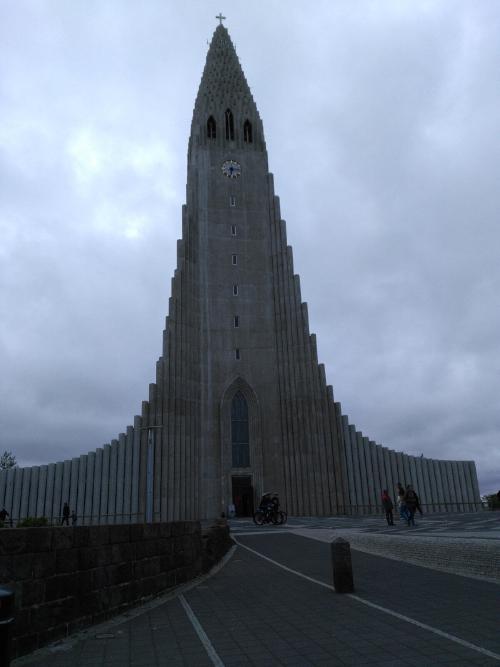
At the supermarket, we bought Parmesan (598ISK/approx. 5,70$), Gouda (889ISK/approx. 8,50$) and two bottles of a cider soft drink (1.5L each 198ISK/1,90$). Soft drinks are not that expensive in comparison to food.
In front of the supermarket, we met an elderly woman with her dog. There was also a cat always walking beside the dog and she told us, that the cat didn’t belong to her, instead the dog and cat were good friends. We had a little chat and then went to the campsite.
Campsite in Reykjavík
You can also take bus lines, but Reykjavík is not that large, so we walked the whole way. Even though we carried 30kg on our backs, it was doable. One part of the way led us along the waterside and was very pretty, even though there was some rain.
The campsite is located near a big swimming bath and is pretty large. Next to tents, there’re also places for caravans and campers. The reception is in a house with a communal kitchen and a small shop. In front of the reception are benches, tables, showers, toilets and big garbage containers. Everything looked nice and clean.
The price was – for us Germans – pretty expensive: One night for two persons in one tent costs about 4800ISK (approx. 45,70$).
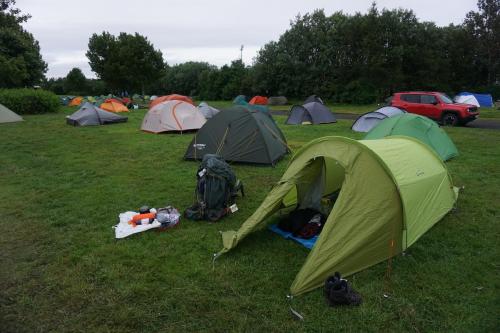
Buying white spirit (second attempt)
After building up our tent on the rather full meadow and preparing our first trekking meal, we noticed that the “white spirit” be bought wasn’t working. At that time we didn’t know that we actually bought lamp oil, so we trotted a bit confused to the reception to get some help.
A helpful lady at the reception cleared the situation and told us that be bought lamp oil. She even called the N1 gas station and asked if we could return the bottles. To find real white spirit, we, slightly edgy and frustrated, searched for another gas station and found one. We bought three bottles of “Coleman Bensin” (each 1790ISK/approx. 17$). Pretty expensive but we were hungry, nervous and had to get up early on the next day.
The stuff we bought produces a lot of soot but it worked very well. Too good to be true: We always diluted it with a bit of water (depending on wind and temperature) so it doesn’t burn that strong. Without water the flame was too high and strong that even the cooker lid could not extinguish it!
After dinner, we tried to sleep and directly noticed that the night is far from being dark. A small scarf or mask to cover your eyes is very helpful in the Icelandic summer!
Day 2: Reykjavík → Þórsmörk → Bjórgil
Jul 19, 2018
Departure from Reykjavík
We stood up at 6 a.m. and our bus left at 7:15 a.m. to Þórsmörk. Some people were already waiting at the bus stop, which is directly located at the entrance to the campsite. Among others, there was a couple from Germany hastily wrapping their backpacks in plastic bags. They heard that the luggage compartments of the buses may be flooded (which is not unlikely on deeper fords). After hearing that, we got a bit worried and also wrapped our backpacks in huge plastic bags, which we originally wanted to use for clothes and the sleeping bag. Unfortunately, our backpacks were too large and everything looked more funny than helpful.
After a few minutes, the bus arrived and drove us to the BSÍ, where we had to change. So we unloaded the backpacks, unwrapped them (in case of doubt, they weren’t that helpful) and after a couple of minutes, the actual bus left the BSÍ.
Drive to Þórsmörk
The journey was relaxing and we were able to gather some impressions. We had to change again in Hvolsvöllur but this time into an older, more robust bus suitable for the terrain. Now we drove into the highland, which was much more interesting for us.
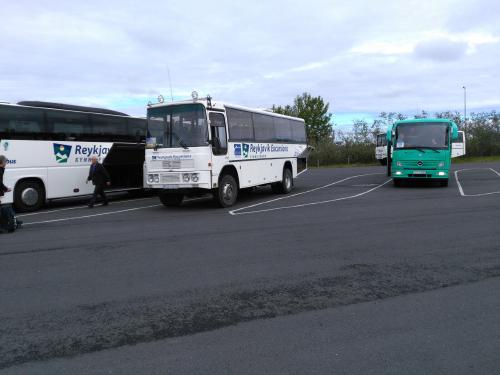
After a while on the main ring road, we turned left, passed the Seljalandsfoss and went further into the inland. The normal road soon turned into a gravel track maintained by some wardens/rangers we passed. After several smaller fords, the driver made a little break at the Gigjökull glacier so that we could take some pictures. Afterward, the journey continued to Þórsmörk where we had to cross a larger river.
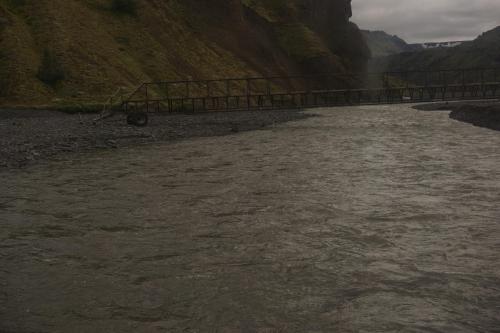
Repack and let’s go
We arrived at 2 p.m., admired the big jeeps and walked to the campsite to repack our backpacks. We packed our backpacks very poorly in the morning because we had little time. We also tested our cooker again to become familiar with its usage (due to the strange white spirit we bought).
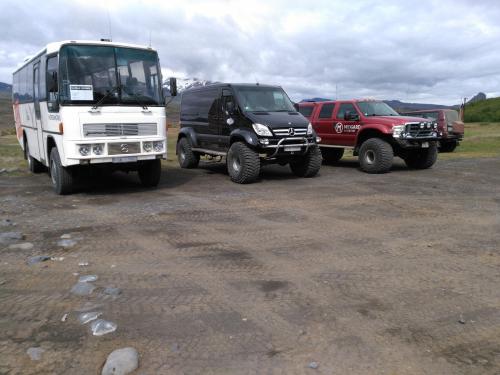
Kristina asked the guy in the campsite reception what the weather may look like to find out if any big bad weather was coming up. The only answer she got was “Well, there will be weather”.
After repacking and taking a nice photo in front of the Markarfljót (s. below), it was time to start our journey. Þórsmörk is very beautiful, green, forested (Þórsmörk translates to forest of Þór (thor)) but also pretty steep. Because the first bit of our journey followed the Laugavegur, we met many other people hiking toward Þórsmörk. It was so warm that day that we started hiking without even wearing any jacket.
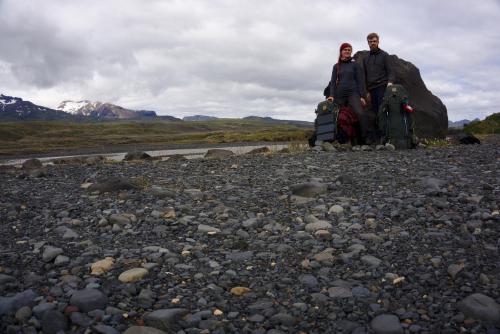
After completing our first ford, which wasn’t deep but pretty cold, we hiked further uphill, this time without a forest. Towards the evening, the temperature dropped and did a little break at a small but wild river. After taking some photos, filling up our water bottles and eating our dinner, we passed an adventurous bridge to the other side.
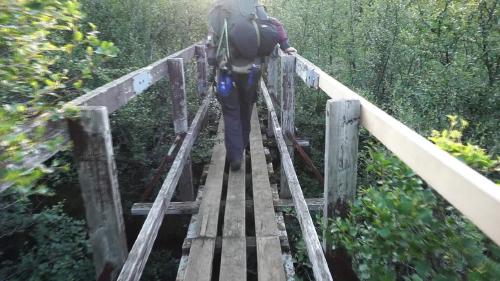
We then created our camp a bit downstream behind a larger bush. Being pretty exhausted but in a good mood, we marked our first camp on our hiking map.
Day 3: Bjórgil → Bíldufell
Jul 20, 2018
The alarm clock rang at 8:30 a.m. While eating our breakfast, we already saw a lot of hikers on the Laguavegur, which had to get up incredibly early on the next campsite (Botnar, approx. 7 km / 4.5 mi away). Somehow comprehensible, because there were a lot more hiking groups later in the day.
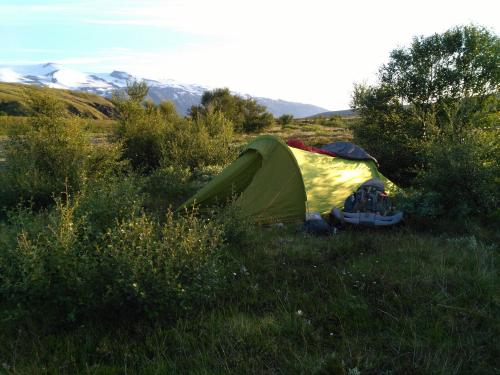
One couple crossed our way, we asked them how far the campsite Botnar is away and came to the conclusion that we hiked not nearly as far as we thought we did. Later in the evening and disillusioned, we corrected the position of our camp on the map.
But first, we walked further along the Markarfljót, which runs through an approx 80 m / 260 ft deep canyon. Before entering the plain Sandar and passing the river Fremri-Emstruá, we had a breathtaking view through the canyon (s. below). But only because we left the normal hiking path!
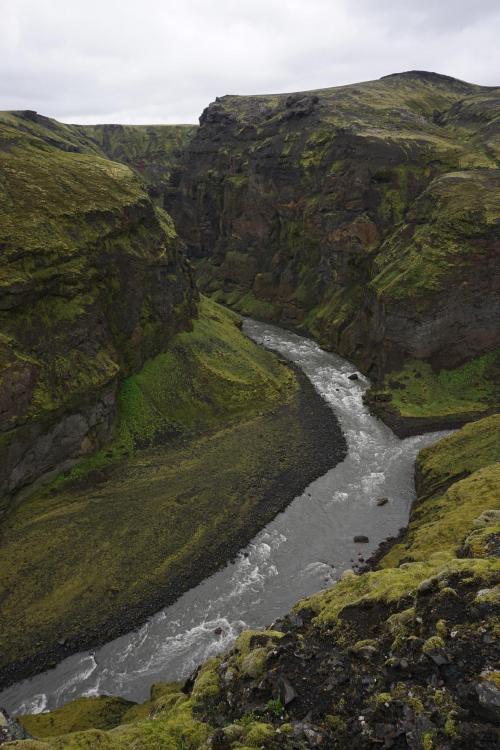
The Bridge over the Fremri-Emstruá looked pretty adventurous and the slopes were very steep. After passing the bridge, we did not went uphill to the Botnar campsite but turned right towards the Entujökull glacier.
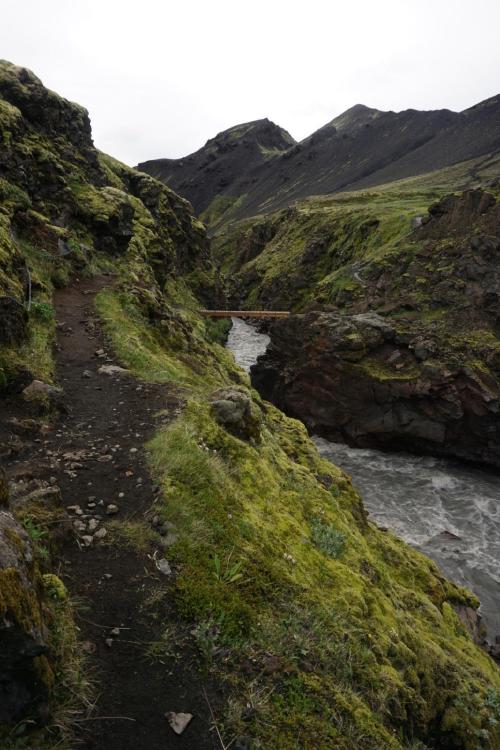
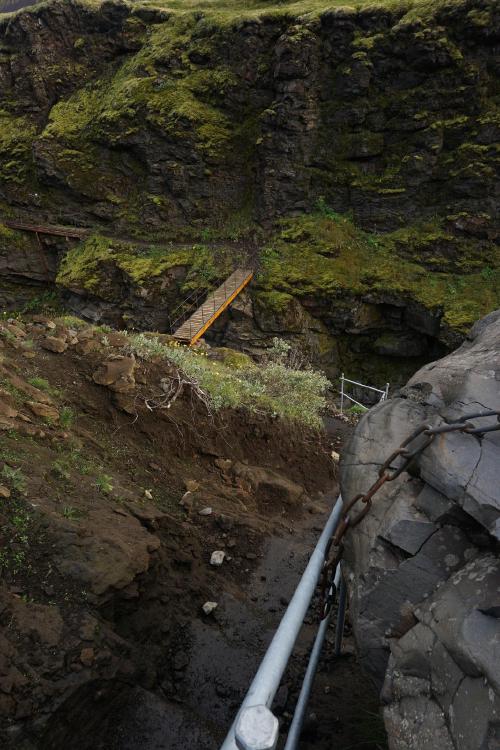
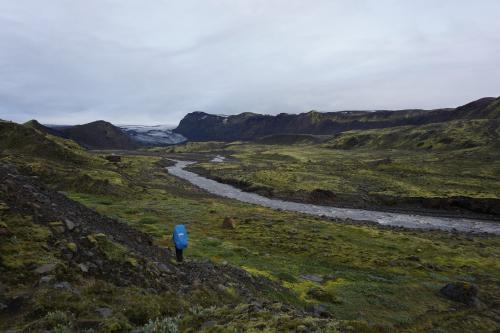
There were no hiking paths anymore (sometimes trails, but probably from sheeps) and we should not meet any other human for the next four days. Therefore, we had to use our navigation skills to find our location on the hiking map.
We placed our tent near the Bíldufell on a place without vegetation on it (to not harm the sensitive moss, s. below). The last two kilometers for that day consisted of a former river bed and was quite difficult for us to hike. Especially the hills were very steep and slippery.
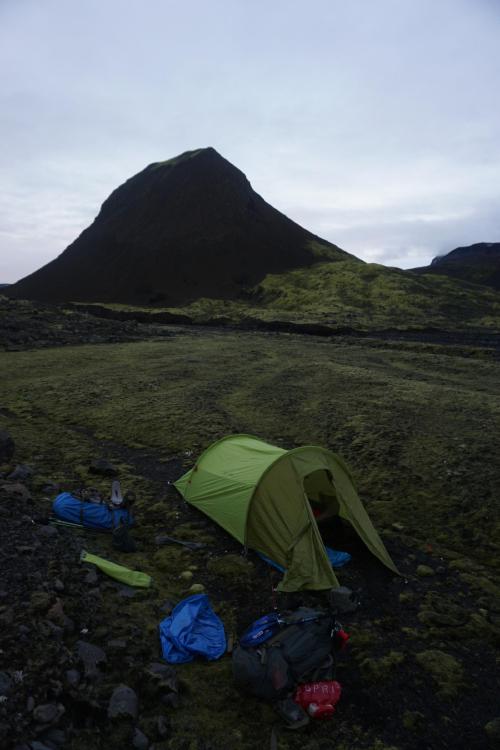
Not far from the tent ran the river Fremri-Emstruá, which consisted of very turbid water, so the water filter was definitely worth it. Nevertheless, we let the water stand overnight so the contained solids could settle.
Next report (part 2)
I hope you enjoyed this first part of our reports. We were 24 days in Iceland, so there will be a lot of reports. But I promise you, it won’t get boring ;)